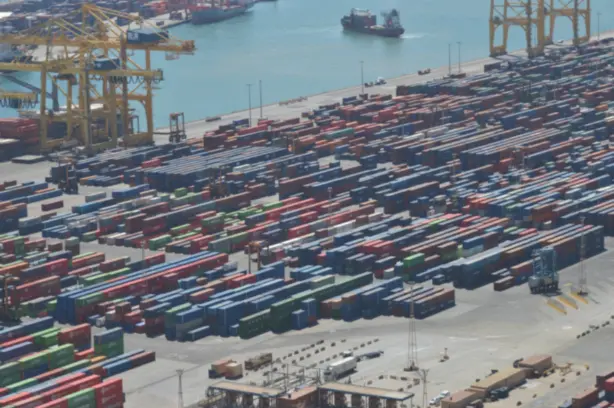By Preserve Gold Research
Not even a week after advocating for diplomacy at the United Nations General Assembly, Iran’s new president, Masoud Pezeshkian, made his stance clear on Israel’s “desperate barbarism” and “crimes against humanity.” In a surprise attack in early October, around 200 missiles were launched toward Israel, with several making contact in major cities such as Tel Aviv. The strike is Iran’s second attack on Israel this year, following a similar incident in April. Amid rising tensions, Iran’s Mission at the United Nations released a statement that warned: “Should the Zionist regime dare to respond or commit further acts of malevolence, a subsequent and crushing response will ensue.”
In a world already teetering on the edge of economic uncertainty, the escalating conflict between Israel and Iran has revived fears of another major disruption. Israel’s vow to retaliate against Iran for its barrage of ballistic missiles has left experts speculating about the potential consequences. Could this conflict threaten global energy supplies once again? And what impact could it have on the U.S. economy? While the full extent of the fallout remains to be seen, experts warn that the conflict could have far-reaching effects on both energy markets and the economy as a whole.
Potential Impact on Oil Markets
Following Iran’s strike on Israel, oil prices rose from $71 a barrel to over $81 per barrel, with analysts predicting that the prices could potentially reach $100 per barrel in the coming months if the conflict continues. Historically, such crises have strained global oil supplies, causing major disruptions and sharp price spikes. In 1973, the Arab oil embargo against Israel’s allies caused oil prices to quadruple, leading to widespread shortages and panic buying. At the time, the U.S. economy relied heavily on cheap oil imports, and the shock of higher prices caused a recession that lasted for years. While the U.S. has since diversified its energy sources, it remains one of the world’s largest oil consumers and is still vulnerable to price shocks.
Several factors now loom over the stability of oil prices in the wake of the Iran-Israel conflict. The Strategic Petroleum Reserve (SPR), although meant to provide a cushion for supply disruptions, has only a fraction of its capacity filled. While it’s been slowly replenished this year, its current levels are still considerably lower than in previous years and only enough to offset a few weeks of oil import disruptions. Low reserves hinder the U.S. government’s ability to stabilize prices effectively should the situation deteriorate, which could lead to price hikes and impact consumers’ pocketbooks. Separately, OPEC and its allies’ recent efforts to curb production have reduced global oil inventories. With less spare capacity available, the global market is more susceptible to supply shocks and could exacerbate any disruptions that may arise. While the group is still sitting on a nearly 5 million barrel per day surplus, the supply-demand balance could easily shift should the conflict escalate.
As Israel deliberates on potential military action and the U.S. contemplates its own response, markets are bracing for any potential fallout. Analysts point to three possible scenarios that could play out in the coming months, each with varying degrees of impact on oil prices.
Scenario 1: Attack on Iranian Oil Infrastructure
In the event of a direct attack on Iranian oil infrastructure or ports, experts predict that the impact on global oil prices could be swift and severe. Iran is a major player in the global oil market, with its production accounting for around 3% of total world output. If Israel targets Iranian oil facilities, global supply could be reduced by almost 2 million barrels per day, an amount that market experts say could push oil prices to triple digits. “If you [Israel] take out oil installations in Iran, easily you [oil prices] could go to $200 plus,” warned Bjarne Schieldrop, chief commodities analyst at SEB. This would be a significant blow to global economies already struggling with high prices and supply constraints.
Scenario 2: Disruption of Persian Gulf Shipping
The Persian Gulf, through which almost one-third of the world’s seaborne oil passes, could also be a target for either side in the conflict. As one of the world’s most critical oil transit points and a global supply bottleneck, any shipping disruption in this region could have widespread, catastrophic impacts on energy costs worldwide. With natural gas exports from Qatar also potentially affected, experts say the ripple effects of any blockage could be felt keenly across global markets, particularly as demand surges during the approaching northern hemisphere winter.
“If [transit through the Strait of Hormuz] was to be impacted, we’re talking about an oil price impact that would be three times larger than the oil price shocks of the 1970s in the wake of the Iranian revolution and the Arab oil embargo, and now we’re talking about $150 plus a barrel of oil,” said Saul Kavonic, energy analyst at MST Financial. Kavonic isn’t alone in his assessment; other industry experts also echo his concerns. “If worst came to worst and the Strait of Hormuz was closed for a month or more, then Brent crude would likely spike to USD 350/b, the world economy would crater, and the oil price would fall back to below USD 200/b again over some time,” said Schieldrop in a note to clients.
Scenario 3: Stricter Enforcement of Iranian Oil Sanctions
In response to Iran’s missile strike on Israel, the U.S. recently announced plans to expand sections to include restrictions on petroleum and petrochemicals trade with Iran. By targeting Iran’s economic sectors critical for generating revenue, including the “Ghost Fleet,” which facilitates covert oil sales, the U.S. hopes to “help further deny Iran financial resources used to support its missile programs.”
Whether or not the restrictions will be enough to dissuade Iran from further aggressive actions is yet to be seen. But the implications for global oil markets are already being felt. If the U.S. continues to tighten its sanctions on Iran and pressures major partners like China to curtail their purchases of Iranian oil, 90% of Iran’s export market could be affected. “China would feel the impact of any disruption most directly,” said Richard Bronze, cross-energy analyst at Energy Aspects. “But any significant loss of Iranian supply would be felt in the wider market, as Chinese buyers would need to find alternative supplies, increasing competition and pushing up prices.”
Not Mutually Exclusive Scenarios
While the above three scenarios present a potential cause for oil prices to increase, they aren’t mutually exclusive. By themselves, each event has the potential to disrupt global oil markets and drive up prices. But combined, they could create a perfect storm for oil prices to skyrocket.
Expert insights underscore the gravity of the situation. Raad Alkadiri, a Senior Energy Security and Climate Change Program Associate noted, “The war in the Middle East will continue to buffet oil prices over the next few weeks and months, with Israel’s prosecution of the war a leading factor in future supply risk.” And if tensions between Iran and Israel continue to escalate, the possibility of a full-blown war cannot be ruled out. While strategies like tapping into the SPR may offer temporary relief, there is no long-term solution to a sustained disruption of oil supplies in the absence of a diplomatic resolution. The fate of the global oil market rests on a delicate balance between supply and demand, and any event that threatens this balance can send prices soaring.
Economic Impact to Americans
It’s no secret that rising oil prices have a direct impact on the wallets of American consumers. With the U.S. being one of the largest oil-consuming countries in the world, any increase in oil prices has a knock-on effect on everyday goods and services. Higher oil prices translate to higher gasoline prices, leading to increased costs for transportation, production, and distribution of goods. And with the U.S. economy heavily dependent on consumer spending, any increase in prices can have a ripple effect on overall economic growth.
In a recent paper published by the National Bureau of Economic Research, researchers found that a mere 6% increase in oil prices could reduce U.S. GDP by 20 to 30 basis points. Such a scenario could also elevate price levels by 20 basis points, compounding inflationary woes and translating to a real wage reduction of up to 10 basis points. These figures may seem small, but at a time when millions of Americans are struggling to make ends meet, any additional burden on their wallets can have devastating effects on their financial well-being.
Markets, too, have not been immune to the fallout of escalating tensions in the region. In the days following October’s attack on Israel, the facade of stability in the stock market quickly deteriorated, with energy stocks plunging and markets across the globe experiencing sell-offs. While short-lived, these events highlight the interconnectedness of global markets and the vulnerability of investors to geopolitical turmoil in oil-producing regions. As a key driver of market dynamics, investor sentiment can quickly sour in the face of uncertainty. And for those left holding the bag, there is often little recourse but to ride out the storm and hope for a swift resolution.
Beyond market jitters, the specter of diminished consumer confidence and spending looms large for American businesses. With higher energy costs eating into household budgets, consumers are often forced to cut back on discretionary spending. We’ve seen this play out before in the aftermath of past oil price shocks, like the 1970s, when a steep spike in oil prices led to widespread economic downturns and layoffs across various industries. Despite having a more diversified economy than in decades past, the U.S. is still heavily reliant on oil as a primary energy source, leaving many sectors vulnerable to supply disruption and price fluctuations.
What’s Next?
The current state of affairs in the Middle East serves as a sobering reminder of the fragility of our global energy system and its impact on everything from individual finances to international relations. With Israel vowing that “Iran will face consequences for its actions” and Iran threatening retaliation, tensions in the region remain high. As history has shown, conflict in this part of the world has a way of spiraling out of control quickly, leaving many wondering what the future holds. If there is spill-over into other industries and markets, how will businesses adapt and survive? Will we see a repeat of past recessions, or will the U.S. be able to weather the storm with its more diversified economy?
For Americans who suffered through the 16-month recession that followed the 1970s oil shocks, recent events may feel like a haunting flashback to a time when oil prices skyrocketed, inflation soared, and job losses were commonplace. However, the lessons learned from the past can serve as a guide for navigating the uncertain terrain ahead. Those who turned to the stability offered by commodities like gold and silver found themselves more stable financially than those who didn’t. Gold prices surged by 35% in the years following the oil crisis, silver prices quadrupled, while the stock market plunged by double-digits.
As long as the world continues to rely heavily on energy resources, conflicts and disruptions in the Middle East will continue to drive volatility in the oil market. But by diversifying savings and hedging against inflation with precious metals, the sharp turns and twists of the oil market don’t have to derail personal financial stability. With analysts suggesting that the price of gold could breach the $3,000 mark in the near future, experts say that now is the time for investors to consider adding physical gold and silver to their savings. As the saying goes, those who do not learn from history are doomed to repeat it, and the lesson from the 1970s oil shocks is clear – diversification is key.







